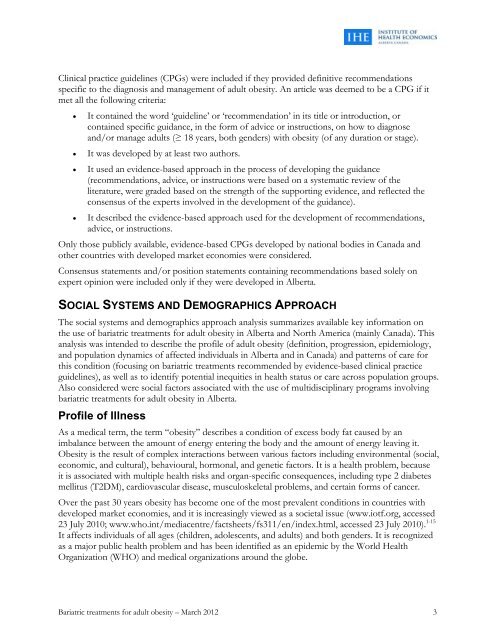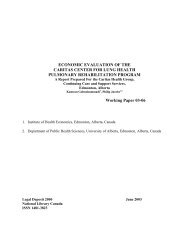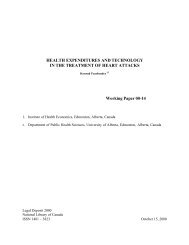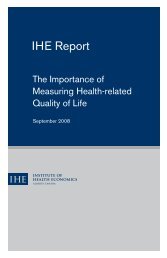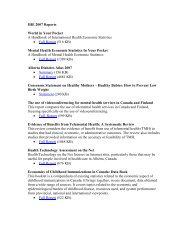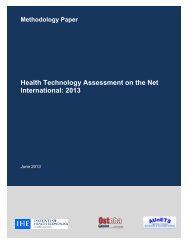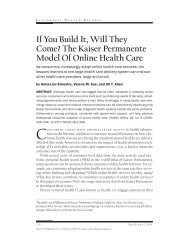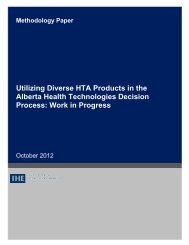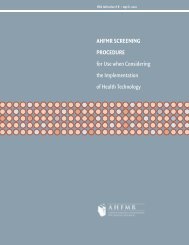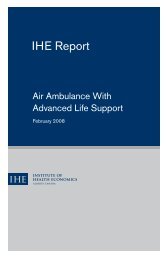Bariatric treatments for adult obesity - Institute of Health Economics
Bariatric treatments for adult obesity - Institute of Health Economics
Bariatric treatments for adult obesity - Institute of Health Economics
- No tags were found...
You also want an ePaper? Increase the reach of your titles
YUMPU automatically turns print PDFs into web optimized ePapers that Google loves.
Clinical practice guidelines (CPGs) were included if they provided definitive recommendationsspecific to the diagnosis and management <strong>of</strong> <strong>adult</strong> <strong>obesity</strong>. An article was deemed to be a CPG if itmet all the following criteria:It contained the word ‘guideline’ or ‘recommendation’ in its title or introduction, orcontained specific guidance, in the <strong>for</strong>m <strong>of</strong> advice or instructions, on how to diagnoseand/or manage <strong>adult</strong>s (≥ 18 years, both genders) with <strong>obesity</strong> (<strong>of</strong> any duration or stage).It was developed by at least two authors.It used an evidence-based approach in the process <strong>of</strong> developing the guidance(recommendations, advice, or instructions were based on a systematic review <strong>of</strong> theliterature, were graded based on the strength <strong>of</strong> the supporting evidence, and reflected theconsensus <strong>of</strong> the experts involved in the development <strong>of</strong> the guidance). It described the evidence-based approach used <strong>for</strong> the development <strong>of</strong> recommendations,advice, or instructions.Only those publicly available, evidence-based CPGs developed by national bodies in Canada andother countries with developed market economies were considered.Consensus statements and/or position statements containing recommendations based solely onexpert opinion were included only if they were developed in Alberta.SOCIAL SYSTEMS AND DEMOGRAPHICS APPROACHThe social systems and demographics approach analysis summarizes available key in<strong>for</strong>mation onthe use <strong>of</strong> bariatric <strong>treatments</strong> <strong>for</strong> <strong>adult</strong> <strong>obesity</strong> in Alberta and North America (mainly Canada). Thisanalysis was intended to describe the pr<strong>of</strong>ile <strong>of</strong> <strong>adult</strong> <strong>obesity</strong> (definition, progression, epidemiology,and population dynamics <strong>of</strong> affected individuals in Alberta and in Canada) and patterns <strong>of</strong> care <strong>for</strong>this condition (focusing on bariatric <strong>treatments</strong> recommended by evidence-based clinical practiceguidelines), as well as to identify potential inequities in health status or care across population groups.Also considered were social factors associated with the use <strong>of</strong> multidisciplinary programs involvingbariatric <strong>treatments</strong> <strong>for</strong> <strong>adult</strong> <strong>obesity</strong> in Alberta.Pr<strong>of</strong>ile <strong>of</strong> IllnessAs a medical term, the term “<strong>obesity</strong>” describes a condition <strong>of</strong> excess body fat caused by animbalance between the amount <strong>of</strong> energy entering the body and the amount <strong>of</strong> energy leaving it.Obesity is the result <strong>of</strong> complex interactions between various factors including environmental (social,economic, and cultural), behavioural, hormonal, and genetic factors. It is a health problem, becauseit is associated with multiple health risks and organ-specific consequences, including type 2 diabetesmellitus (T2DM), cardiovascular disease, musculoskeletal problems, and certain <strong>for</strong>ms <strong>of</strong> cancer.Over the past 30 years <strong>obesity</strong> has become one <strong>of</strong> the most prevalent conditions in countries withdeveloped market economies, and it is increasingly viewed as a societal issue (www.iotf.org, accessed23 July 2010; www.who.int/mediacentre/factsheets/fs311/en/index.html, accessed 23 July 2010). 1-15It affects individuals <strong>of</strong> all ages (children, adolescents, and <strong>adult</strong>s) and both genders. It is recognizedas a major public health problem and has been identified as an epidemic by the World <strong>Health</strong>Organization (WHO) and medical organizations around the globe.<strong>Bariatric</strong> <strong>treatments</strong> <strong>for</strong> <strong>adult</strong> <strong>obesity</strong> – March 2012 3


